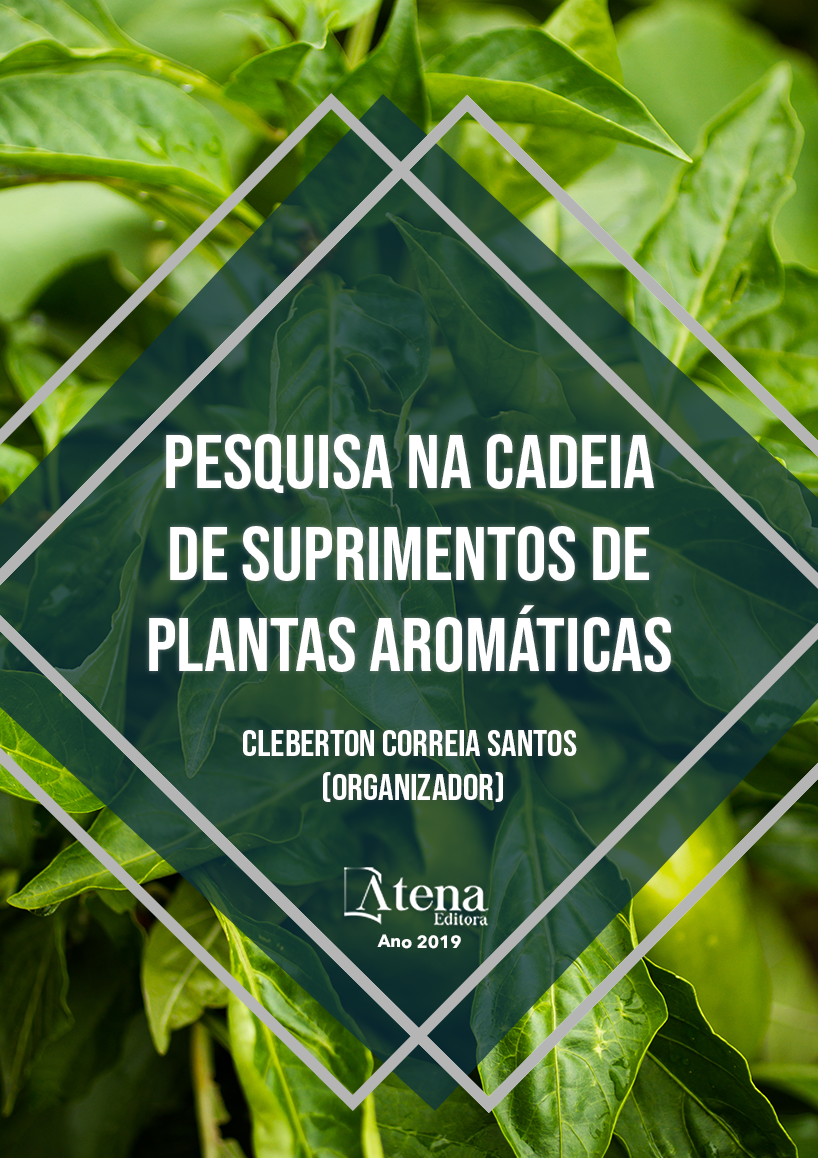
RENDIMENTO E COMPOSIÇÃO QUÍMICA DO ÓLEO ESSENCIAL DAS FOLHAS DE Eugenia uniflora L. EM DIFERENTES TEMPOS DE EXTRAÇÃO
A família Myrtaceae está
representada por 132 gêneros e 5671 espécies
e tem como centros de diversidade os trópicos
úmidos, especialmente na América do Sul,
Austrália e Ásia Tropical. Este trabalho avaliou
o rendimento e a composição química do óleo
essencial das folhas secas de Eugenia uniflora
em diferentes tempos de extração pelo método
de hidrodestilação. O material botânico foi
coletado no campus do Museu Emílio Goeldi,
Belém, Pará, nos meses de janeiro e setembro
às 08h. As amostras (triplicatas) foram
submetidas à hidrodestilação em sistemas
de vidro do tipo Clevenger original durante
1, 2, 3 e 4 horas. Os óleos essenciais foram
analisados através de cromatografia em fase
gasosa acoplada à espectrometria de massas
(CG/EM) em sistema Shimadzu QP-2010 Plus
equipado com coluna capilar RTx-5MS (30 m
× 0,25 mm; 0,25 μm de espessura de filme).
O aumento do rendimento do óleo essencial
das folhas de E. uniflora foi proporcional ao
incremento no tempo de extração, tanto para
o material coletado em setembro (1,1 a 2,3%)
quanto em janeiro (1,4 a 3%).Os constituintes
químicos majoritários do óleo essencial das
folhas secas de E. uniflora mostraram variações
percentuais em função do tempo de extração,
principalmente os que caracterizam o tipo
químico da espécie: selina-1,3,7(11)-trien-8-
ona e epóxido de selina-1,3,7(11)-trien-8-ona.
As maiores concentrações de selina-1,3,7(11)-
trien-8-ona, epóxido de selina-1,3,7(11)-trien-
8-ona e γ-elemeno foram observadas no mês
de setembro (43,3± 2,7%), enquanto a maior
concentração de (E)-cariofileno se deu no mês
de janeiro (6,4 ± 0,1%).
RENDIMENTO E COMPOSIÇÃO QUÍMICA DO ÓLEO ESSENCIAL DAS FOLHAS DE Eugenia uniflora L. EM DIFERENTES TEMPOS DE EXTRAÇÃO
-
DOI: 10.22533/at.ed.6219130095
-
Palavras-chave: Myrtaceae, hidrodestilação, sazonalidade.
-
Keywords: Myrtaceae, hydrodistillation, seasonality.
-
Abstract:
Myrtaceae family is represented by 132 genera and 5671 species and
has as centers of diversity the humid tropics, especially in South America, Australia and
Tropical Asia. This work evaluated the yield and chemical composition of the essential
oil of Eugenia uniflora leaves at different extraction times by the hydrodistillation
method. The botanical material was collected on the Campus of the Emílio Goeldi
Museum, Belém, Pará, in the months of January and September at 8h. The samples
(triplicate) were submitted to hydrodistillation using original Clevenger type for 1, 2,
3 and 4 hours. The essential oils were analyzed by gas chromatography coupled
to mass spectrometry (GC/MS) in Shimadzu QP-2010 Plus system equipped with
capillary column RTx-5m(30 m × 0.25 mm; 0.25 μm film thickness). The increase in
the essential oil yield of E. Uniflora leaves was proportional to the increment in the
extraction time, both for the material collected in September (1.1 to 2.3%) as in January
(1.4 to 3%). The major chemical constituents of the essential oil of the dry leaves of E.
Uniflora showed percentage variations as a function of the extraction time, especially
those that characterize the chemical type of the species: Selina-1, 3, 7 (11)-Trien-
8-one and epoxide of Selina-1, 3, 7 (11)-Trien-8-one. The highest concentrations of
Selina-1, 3, 7 (11)-Trien-8-one, Selina-1, 3, 7 (11)-Trien-8-one and γ-elemene epoxide
were observed in September (43.3 ± 2.7%), while the highest concentration of (E)-
caryophyllene occurred in the month of January (6.4 ± 0.1%).
-
Número de páginas: 15
- Márcia Moraes Cascaes
- Luís Henrique Araújo Oliveira
- Eloisa Helena de Aguiar Andrade
- Lidiane Diniz do Nascimento


